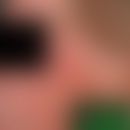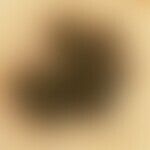Synonym(s)
DefinitionThis section has been translated automatically.
- Procedure for viewing the epidermis, epidermodermal junction zone and upper dermis through a microscope placed directly on the oil-soaked horny layer with a glass plate.
- Qualified reflected light microscopy allows reliable differentiation of melanocytic from non-melanocytic "pigmentary tumors" and detection of early melanomas.
- In patients with multiple dysplastic melanocytic nevi, risk stratification can be used to preselect nevi to be excised. In addition, information on medical history, number of tumors, and patient compliance is absolutely necessary. Especially in melanoma diagnostics, information about tumor growth can be obtained, see also ABCD rule, dermatoscopic.
- Qualified, sequential digital reflected-light microscopy (also sequential digital dermoscopy) can significantly improve the early detection of malignant melanoma (recommendation grade B, evidence level 2b).
- Furthermore, incident light microscopy is used for dignity assessment of non-melanocytic initial and small lesions, preoperative incision margin control, early detection of side effects of topical drugs, detection of microparasites, and basic cosmetologic diagnosis.
General informationThis section has been translated automatically.
- Structural phenomena:
- It is important to assess the corneal layer (keratinous colour), the reticular structure, the papillary body (mesh centre), the skin vessels (central capillaries, subepidermal horizontal vascular plexus) as well as the hair follicles and sweat gland ostia.
- Vital-histological stratification: Within the framework of a rational diagnosis, the description and evaluation of light microscopic characteristics according to their localisation within the topographically and anatomically defined skin layers is carried out.
- Orthohyperkeratosis: Increased light reflectivity, whitish to silvery white, opaque. In areas of exfoliation the keratinic colour is brownish to yellowish red (e.g. in dyskeratosis follicularis). A peeling of epidermal layers in the stratum spinosum makes the central capillaries of the papillary bodies visible.
- Hypergranulose (e.g. in lichen planus) leads to semi-transparent, whitish opaque areas. Thickenings in the stratum spinosum (acanthosis) can be recognised by reflected light microscopy by their naked papillary aspect (greater transparency). The vertically ascending central capillaries of the papillary bodies are clearly visible.
- In squamous cell carcinomas, newly formed bizarre vessels (tumor vessels) determine the basic architecture (e.g. in vulvar carcinoma). Irregularly proliferating capillaries are no longer bound to the papillary body; they break through the anatomically predetermined boundaries.
- Pigment formations:
- In verruca seborrhoica (reticulated adenoid type), the reticulated cell strands often absorb abundant melanin pigment, so that a pigment network becomes visible in reflected light projection (without double contour). In this way this type of Verruca seborrhoica imitates a pigment cell lesion.
- The melanin-pigmented epidermal reticules, which appear net-like in the incident light plane, are separated from the cone-like, connective tissue papillary bodies by the stratum basale. The shape of the reticular strata depends on the pigmentation strength of the melanocytes and basal keratinocytes as well as the length of the reticular strips. Net patterns are created by an overlapping effect of the melanin on the steep slopes of the reticulated cones. People with dark skin colour or people with a strong tan show a continuous fine, double-contour reticular pattern. Massive transepidermal melanin ejection via the reticules can cause reticular projection patterns in the stratum corneum (e.g. in dysplastic melanocytic nevi).
- Papillary body unit and corial vessels: In light skin, localization of the papillary body unit is only possible if a central capillary is visible. Intracapillary thrombus formation (e.g. in Purpura fulminans), indicates the density of the papillary body. In hemangiomas or haemolymphangiomas, sagging vessels fill the spaces between the reteleases (e.g. in lymphangioma circumscriptum). Blood or lymph caverns (lacunae) lined with endothelium are formed, which press the connective tissue contained in the papillary body against the reteleases (whitish connective tissue septa).
- In contrast to the vertically aligned vessels of the dermal papillae, the blood vessels at the border of the stratum papillare to the stratum reticulare are arranged horizontally. In erythrosis interfollicularis colli the horizontal vascular plexus is visible in reflected light. Some inflammatory-tumorous processes are accompanied by an accumulation of loosely aggregated melanophages in the immediate vicinity of blood vessels (perivascular melanophages). This phenomenon is frequently observed in inflammatory irritated seborrhoeic keratoses, basal cell carcinomas, bowenoid papulosis and less frequently in Bowen's disease.
- Pigment tumours:
- In pigment cell tumors, melanin pigment of varying density accumulates in the tip area of the usually hypertrophic papillary body above the central capillary, which appears spherical in the projection plane (so-called gray centropapillary globules). Both melanophagous nests and nevus cell nests or atypical melanocytes can cause a globulus phenomenon (e.g. in melanocytic compound nevi or superficial spreading melanomas).
- Melanocyte nests in the papillary body cause a grey to greyish (slate grey) tint under reflected light microscopy (e.g. in melanocytic nevi of the compound type Junction nevus). The round, oval or polygonal foci are located within the reticulum or in the centre of the dermal papillae. In some cases they protrude from the reticules into the papillary body. The cell nests are relatively evenly pigmented, usually smaller than 0.1 mm in maximum diameter. Melanin pigment released transepidermally can overlay the original focus and simulate a localization in the upper epidermal layers.
- Junctional cell nests of malignant melanomas project themselves in incident light as "sack-like" formations (sacculi) with diameters up to 0.45 mm (e.g. in acrolentiginous malignant melanomas). In contrast to irregularly pigmented cobblestone patterns made of polygonal, keratin-bounded plaques in benign melanocytic nevi of the compound nevus type, sacculi usually have blurred, rather blurred boundaries and homogeneous pigmentation within a cell nest. Depending on the pigment content or the degree of neovascularisation, sacular patterns show yellowish-brownish, reddish-brownish grey, red-light brown, red-blue or greyish-bluish opaque tones (e.g. in malignant melanomas).
- Rapidly growing space-occupying melanoma bandages dilate the dermal papillae and compress the local connective tissue (whitish septum formation). This can result in a negative reticular pattern. The cell nests are usually of different sizes, resulting in an overall inhomogeneous picture with large and small saccules, which also discharge more or less considerable melanin pigment portions into upper epidermal layers. In initial cutaneous melanoma metastases similar sacculi are found. When junctional melanoma bandages grow destructively in a strand-like manner without regard to anatomically given limitations, so-called pseudopodia are formed. Digitiform blue-gray strands protrude beyond the tumor border zone. They are bulbously thickened, multi-fingered and sometimes bent or tree-like (e.g. in initial superficial spreading melanomas). Above the pseudopodia localized pigment strips which taper towards the periphery are arranged in radial streaks in the upper epidermal layers (radial streaming).
- Hair sebaceous glands and sweat gland ostia:
- There are three types of hair follicles: terminal hair follicles, vellus hair follicles and sebaceous follicles. In terminal hair, a targetoid aspect can be seen under reflected light microscopy. The central hair (hair shaft) is surrounded by a yellowish-opaque keratin ring. This ring corresponds to the stratum granulosum (inner root sheath) which is lowered into the follicle canal. This is followed by a wider yellowish-whitish opaque ring of vital keratinocytes of the stratum spinosum (outer root sheath). A narrow brown or brownish-grey pigmentary fringe follows peripherally, which corresponds to the more or less melanocyte-occupied stratum basale. In vellus hair follicles, the follicular centre is visible under the reflected light microscope as a yellowish-brown dot or disc. Otherwise, the targetoid aspect corresponds to that of the terminal hair follicle.
- The sebaceous gland ostia also show a targetoid structure with a very narrow ring system. The actual lumen of the sweat gland ostia is only about 0.02 mm in size, while the bright surrounding yard (no pigmentation!) measures 0.08 mm in diameter. With the exception of the palmoplantar region, the ostia of fair-skinned people can only be identified if the surrounding skin has increased pigmentation. On the skin of dark or sun-tanned persons, the round ducts of eccrine sweat glands are surrounded by melanin pigment and can therefore be easily depicted. The ducts themselves do not store melanin. The diameters of the ostia areas are always of the same size, arranged at regular intervals of 0.4 to 0.6 mm (inguinal skin, scalp) and, in contrast to the hair follicles, have no internal structure.
You might also be interested in
IndicationThis section has been translated automatically.
Note(s)This section has been translated automatically.
Dermatological reflected-light microscopy was introduced by Johann Saphir around 1920. He coined the term dermatoscopy. Around 1953, incident light microscopy was extended by vital histology developed by Franz Ehring, i.e. finding and interpreting the histological correlate by means of visual pattern analysis of microanatomical skin structures. In this way, pigmented skin lesions can be better evaluated in terms of localization, geometric shape, surface texture and color.
Computer-assisted reflected-light microscopy achieves a sensitivity of 56% with a specificity of 75% (Del Rosaria et al. 2018).
By means of an attachment to a cell phone (Handyscope or Videodermatoscope), smartphone or camera, panoramic images of the entire tumor can be achieved and stored accordingly.
LiteratureThis section has been translated automatically.
- Altmeyer P (1996) Pitfalls in the diagnosis of pigmented skin tumors. In: Altmeyer P, Hoffmann K, Stücker M (eds) Skin cancer and UV-radiation. Springer, Berlin Heidelberg New York, pp. 971-992.
- Argenziano G, Soyer HP (2001) Dermoscopy of pigmented skin lesions--a valuable tool for early diagnosis of melanoma. Lancet Oncol 2: 443-449
- Bahmer FA, Rohrer C (1990) Video reflected light microscopy of the skin. Akt Dermatol 16: 274-275.
Del Rosario F et al.(2018) Performance of a computer-aided digital dermoscopic image analyzer for melanoma detection in 1,076 pigmented skin lesion biopsies. J Am Acad Dermatol 78:927-934.
Dupuy A et al (2006) Accuracy of standard dermoscopy for diagnosing scabies. J Am Acad Dermatol 56: 53-62.
- Ehring F (1958) History and possibilities of histology on living skin. Dermatologist 9: 1-4
- Rassner G, Holzschuh J (1995) Incident light microscopy. In: Plewig G, Korting HC (eds) Progress in practical dermatology and venereology, vol 14. Springer, Berlin Heidelberg New York, pp 241-245.
- Ruocco E et al (2004) Noninvasive imaging of skin tumors. Dermatol Surg. 30(2 Pt 2): 301-310.
- Schulz C, Stücker M, Schulz H, Altmeyer P, Hoffmann K (1999) Correlation of incident light microscopic characteristics of malignant melanomas with tumor invasion stages according to Clark. Dermatologist 50: 785-790
- Saphir J (1920) The dermoscopy. I. Communication. Arch Dermatol Syph 128: 1-19.
- Schulz H (2000) Epiluminescence microscopy features of cutaneous malignant melanoma metastases. Melanoma Res 10: 273-280
- Stolz W (1997) Incident light microscopic diagnosis of malignant melanoma. In: Garbe C, Dummer R, Kaufmann R, Tilgen W (eds) Dermatologic Oncology. Springer, Berlin Heidelberg New York, pp. 281-289.
- Zalaudek I et al (2004) Clinically equivocal melanocytic skin lesions with features of regression: a dermoscopic-pathological study. Br J Dermatol 150: 64-71
Blum A et al (2022) Panoramic imaging in dermoscopy. Panoramic imaging in dermoscopy. Die Dermatologie 73, 663-665.
TablesThis section has been translated automatically.
Correlation of the incident light microscopic findings with histology and occurrence
Findings |
Description |
Histology |
Occurrence |
Pigment network |
mosaic-like, reticular pattern in front of a homogeneous brown background |
extended, partly widened pigmented retele strips |
Depending on the severity of various benign or malignant skin changes such as melanocytic nevus, dysplastic nevus, malignant melanoma, melanoma in situ, verruca seborrhoica, lentigo maligna |
Pseudo-pigment network |
homogeneous basic pigmentation interrupted by pigment free ostia of the sebaceous and sweat glands |
closely adjacent excretory ducts of sebaceous and sweat glands |
Pigmentary tumors of the face, especially lentigo maligna and lentigo maligna melanomas |
Irregular foothills |
dark, bizarre and sharply defined structures located in the centre or periphery of pigmented skin tumours due to pigment alteration; at first, the mesh strands widen and thicken to form an irregular pattern; as the tumour continues to progress, the mesh structure disappears and irregular extensions are formed |
pigmented, confluent, junctional melanocyte nests |
Pigment tumors, especially at MM |
Radial extensions and pseudopodia |
streaky pigmentation in the tumor periphery, often projection into healthy skin; pseudopodia or radial extensions are visible |
pigmented, marginal melanocyte nests, which are formed fascicularly along the junctional zone |
Regular arrangement as a "halo" especially in pigmented spindle cell tumor; asymmetric arrangement may indicate MM |
brown globules |
light to dark brown, regularly shaped, round or oval, moderately sharply defined |
cap-like distributed superficial pigmentation of melanocytes and melanocyte nests of the dermal papillae |
regular arrangement in dermal, papillomatous, melanocytic nevi; irregular distribution in MM |
Black points |
deep black, sharply defined, round to oval, up to 0.1 mm in size |
Melanocyte or melanin accumulation in the stratum corneum |
peripheral accumulation speaks for MM; rarely occurs in benign melanocytic nevi |
white veils |
white, veil-like pattern on dark brown to black background |
hyperplastic epidermis with compact orthohyperkeratosis and multi-row stratum granulosum |
MM; occasionally dysplastic nevi |
grey-blue arale |
grey-blue to black-grey colouring |
different density of melanophages in papillary dermis |
MM with regressive changes |
Comedo-like follicle opening |
double contoured structure with light courtyard and dark yellow-brown centre |
intraepidermal keratin cysts, which open to the surface with porus |
Verrucae seborrhoicae; rarely in papillomatous, melanocytic nevi |
Pseudocorneal cysts |
circular, moderately blurred white-yellow districts |
intraepidermal, keratin-filled cysts in acantholytic widened epidermis |
|
Leaf-like pigmentation |
leaf-like or finger-like arranged grey-brown-black structure |
Complex pigmented basaloid cells |
pigmented basaliomas |
Reddish-black lacunae |
sharply defined, reddish to deep black areas |
dilated vessels filled with erythrocytes in the upper dermis |
Angiomas, angiokeratomas, hemorrhages |
Variants of the pigment network - Diagnostic significance
Criterion |
ELM image |
Diagnostic significance |
Pigment network (PN) |
Reticular, mosaic-like, brownish pattern |
Melanocytic tumors |
Discrete PN |
Slightly accentuated, light brown PN |
Melanocytic nevi |
Prominent PN |
Distinct dark brown PN |
Rather malignant melanomas |
Regular PN |
Regular net meshes |
Melanocytic nevi |
Irregular PN |
Irregular meshes |
Dysplastic nevi, malignant melanomas |
Fine trabecular PN |
Thin net bars (trabecula) |
Rather benign, melanocytic tumors |
Coarse trabecular PN |
Broadened net bars (trabecula) |
Malignant melanomas, mainly as "melanoma in situ" |
Pseudopigment Network |
Homogeneous pigmentation, interrupted by ostia |
Lentigo maligna, Lentigo maligna melanomas, Verrucae seborrhoica |
Risk group classification
"High-risk" melanocytic tumors |
pigment network and presence of specific reflected-light microscopic melanoma criteria, e.g. radial runners, irregular runners, white fog |
"Medium-risk" melanocytic tumors |
irregular pigment network with edge accentuation without additional reflected light microscopic melanoma criteria |
"low risk" melanocytic tumors |
regular discrete pigment network without additional reflected light microscopic melanoma criteria |
Epiluminescence microscopy criteria for melanoma diagnosis
Criterion |
ELM image |
Irregular pigment network (PN) |
Irregular meshes |
Coarse trabecular PN |
Broadened net bars (trabecula) |
Radial spurs |
Remains of an irregular widened network at the periphery |
Irregular foothills |
Bizarre, relatively sharply defined, roundish to oval points |
"Black dots" |
Black, sharply defined roundish to oval points |
"White Veils" |
Whitish, veil-like pattern on dark background |
Grey-blue areas |
Grey-blue blotchy districts |

























